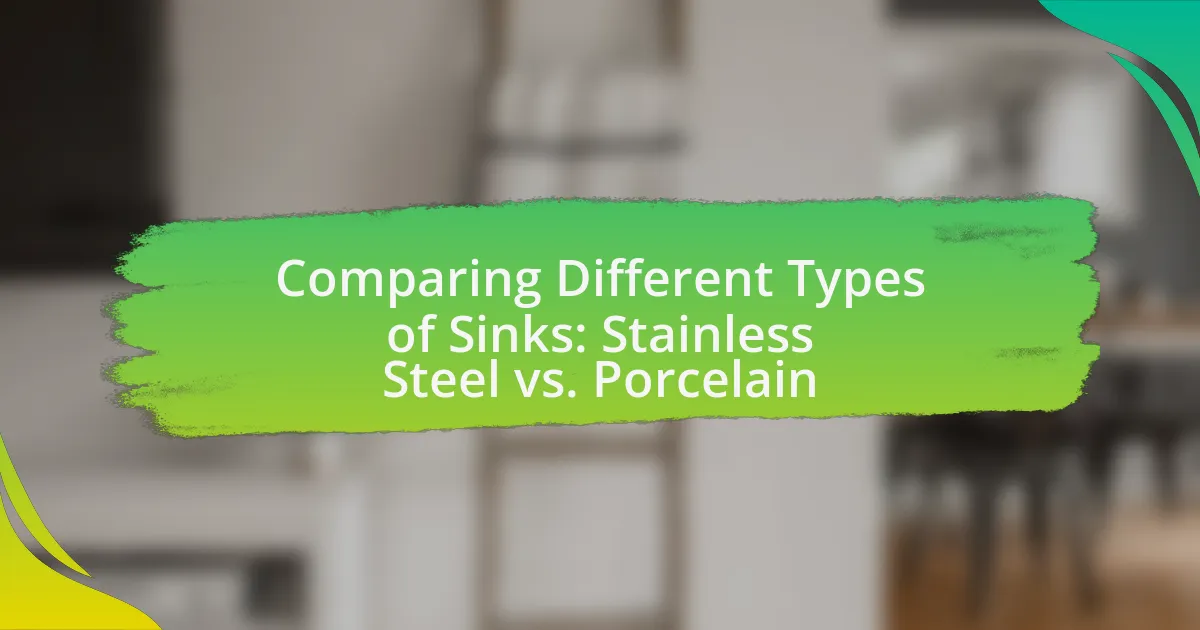The article compares stainless steel and porcelain sinks, highlighting their key differences in durability, maintenance, aesthetics, and cost. Stainless steel sinks are noted for their resistance to rust, stains, and chipping, making them a practical choice for high-use environments, while porcelain sinks offer a classic aesthetic but are more prone to damage. The article also discusses the installation requirements, long-term cost implications, and best practices for selecting the right sink based on lifestyle and usage patterns. Overall, it provides a comprehensive analysis to help homeowners make informed decisions when choosing between these two popular sink materials.
What are the key differences between stainless steel and porcelain sinks?

Stainless steel sinks are durable and resistant to rust and stains, while porcelain sinks are more prone to chipping and scratching but offer a classic aesthetic. Stainless steel is typically lighter and easier to install, whereas porcelain sinks are heavier and may require additional support. Additionally, stainless steel sinks are generally less expensive and easier to maintain, as they can be cleaned with a variety of household cleaners, while porcelain sinks often require gentler cleaning methods to avoid damage.
How do the materials of stainless steel and porcelain affect their durability?
Stainless steel is highly durable due to its resistance to corrosion, rust, and staining, making it suitable for high-use environments. In contrast, porcelain is less durable as it can chip or crack under impact, although it is resistant to scratches and stains. The inherent properties of stainless steel, such as its alloy composition, provide strength and longevity, while porcelain’s brittleness limits its durability in certain conditions.
What factors contribute to the longevity of stainless steel sinks?
The longevity of stainless steel sinks is primarily attributed to their corrosion resistance, durability, and ease of maintenance. Stainless steel is an alloy that contains chromium, which forms a protective layer that prevents rust and corrosion, significantly extending the sink’s lifespan. Additionally, stainless steel sinks are resistant to chipping and cracking, unlike porcelain sinks, which can be more fragile. The non-porous surface of stainless steel also makes it easier to clean and less prone to staining, further contributing to its durability. These factors collectively ensure that stainless steel sinks maintain their functionality and appearance over time.
How does porcelain’s composition influence its lifespan?
Porcelain’s composition significantly influences its lifespan due to the materials used and the firing process involved in its creation. The primary components of porcelain include kaolin, feldspar, and quartz, which contribute to its durability and resistance to wear. High-temperature firing transforms these materials into a dense, non-porous structure, enhancing its strength and longevity. Research indicates that porcelain can withstand thermal shock and resist chipping better than many other materials, which directly correlates to its extended lifespan in various applications, including sinks.
What are the aesthetic differences between stainless steel and porcelain sinks?
Stainless steel sinks have a modern, sleek appearance characterized by their shiny, reflective surface, while porcelain sinks offer a classic, elegant look with a smooth, glossy finish available in various colors. The contemporary aesthetic of stainless steel complements minimalist and industrial designs, whereas the traditional aesthetic of porcelain fits well in vintage or farmhouse-style kitchens. Additionally, stainless steel’s metallic sheen can create a more utilitarian feel, while porcelain’s color options and decorative patterns can enhance the visual warmth and charm of a space.
How do design options vary between stainless steel and porcelain sinks?
Design options for stainless steel and porcelain sinks differ significantly in aesthetics and functionality. Stainless steel sinks typically feature a modern, industrial look with a variety of finishes such as brushed or polished, and they come in various shapes and sizes, including undermount and drop-in styles. In contrast, porcelain sinks offer a classic, elegant appearance with a glossy finish and are often available in more traditional designs, including farmhouse styles. The durability of stainless steel allows for thinner profiles, while porcelain sinks can be more prone to chipping but provide a wider range of color options.
What color and finish choices are available for each type of sink?
Stainless steel sinks are typically available in a brushed or polished finish, with colors primarily in silver or metallic tones. Porcelain sinks, on the other hand, offer a wider range of color options, including white, black, and various pastel shades, often with a glossy finish. The finish of porcelain sinks can also include matte or textured surfaces, enhancing their aesthetic appeal.
How do maintenance requirements differ for stainless steel and porcelain sinks?
Stainless steel sinks require less maintenance compared to porcelain sinks. Stainless steel is resistant to stains, rust, and corrosion, making it easy to clean with mild detergents and a soft cloth. In contrast, porcelain sinks are more prone to chipping and scratching, necessitating careful cleaning with non-abrasive materials to avoid damage. Additionally, porcelain may require periodic sealing to maintain its finish, while stainless steel does not have this requirement.
What cleaning methods are recommended for stainless steel sinks?
Recommended cleaning methods for stainless steel sinks include using a mixture of warm water and mild dish soap, applying baking soda for tough stains, and utilizing vinegar for shine. These methods effectively remove grime and maintain the sink’s appearance. For instance, the combination of baking soda and water creates a gentle abrasive that can lift stubborn stains without scratching the surface, while vinegar helps to eliminate water spots and restore shine due to its acidic properties.
How should porcelain sinks be maintained to prevent damage?
Porcelain sinks should be maintained by regularly cleaning them with a mild detergent and soft cloth to prevent scratches and stains. Using abrasive cleaners or scouring pads can damage the porcelain surface, leading to chips and discoloration. Additionally, promptly addressing any spills, especially from acidic substances like vinegar or lemon juice, helps prevent etching. Regularly inspecting for cracks or chips allows for early repairs, which can extend the lifespan of the sink. Proper maintenance practices are essential, as porcelain is prone to damage from harsh chemicals and physical impacts.
What are the cost implications of choosing stainless steel versus porcelain sinks?

Choosing stainless steel sinks typically involves lower initial costs compared to porcelain sinks. Stainless steel sinks generally range from $100 to $500, while porcelain sinks can cost between $200 and $1,200. Additionally, stainless steel is more durable and resistant to chipping and cracking, potentially leading to lower long-term maintenance costs. In contrast, porcelain sinks may require more frequent repairs or replacements due to their fragility. Thus, the cost implications favor stainless steel for both initial investment and long-term durability.
How do the initial purchase prices compare between the two types of sinks?
The initial purchase prices of stainless steel sinks typically range from $100 to $500, while porcelain sinks generally cost between $200 and $1,000. This indicates that stainless steel sinks are generally more affordable than porcelain sinks. The price difference can be attributed to the materials used and the manufacturing processes involved, with porcelain often requiring more intricate craftsmanship and higher-quality materials, which contribute to its higher price point.
What factors influence the pricing of stainless steel sinks?
The pricing of stainless steel sinks is influenced by factors such as material quality, gauge thickness, brand reputation, design complexity, and additional features. Higher quality stainless steel, such as 304-grade, typically costs more due to its durability and resistance to corrosion. The gauge thickness, which ranges from 16 to 22, affects price; lower gauge numbers indicate thicker steel, leading to higher costs. Brand reputation also plays a role, as established brands often charge a premium for their products. Additionally, intricate designs and features like soundproofing or integrated accessories can increase the price. These factors collectively determine the market price of stainless steel sinks.
How does the cost of porcelain sinks vary based on quality and brand?
The cost of porcelain sinks varies significantly based on quality and brand, typically ranging from $100 to over $1,000. Higher-quality porcelain sinks, often from reputable brands, tend to be more expensive due to superior materials, craftsmanship, and durability. For instance, a well-known brand like Kohler may offer a high-end porcelain sink priced around $800, while a lower-quality option from a less recognized brand might be available for $150. This price disparity reflects differences in manufacturing processes, design features, and warranty offerings, which contribute to the overall value perceived by consumers.
What are the long-term cost considerations for each sink type?
Long-term cost considerations for stainless steel sinks include durability and maintenance, as they typically last longer and require less upkeep than porcelain sinks. Stainless steel is resistant to chipping and cracking, which reduces replacement costs over time. In contrast, porcelain sinks can be prone to chipping and staining, leading to higher repair or replacement expenses. Additionally, the initial purchase price of porcelain sinks is often lower, but their long-term maintenance costs can accumulate due to the need for specialized cleaning products and potential repairs. Therefore, while porcelain may seem cheaper upfront, stainless steel often proves more cost-effective in the long run due to its longevity and lower maintenance needs.
How do repair and replacement costs differ between stainless steel and porcelain sinks?
Repair and replacement costs for stainless steel sinks are generally lower than those for porcelain sinks. Stainless steel sinks are more durable and resistant to damage, which often results in fewer repairs needed over time. In contrast, porcelain sinks can chip or crack more easily, leading to higher repair costs. Additionally, the replacement cost for porcelain sinks tends to be higher due to their material and installation complexity, with prices often ranging from $200 to $600, while stainless steel sinks typically range from $100 to $300.
What impact do maintenance costs have on the overall value of each sink type?
Maintenance costs significantly affect the overall value of each sink type, with stainless steel sinks generally incurring lower maintenance costs compared to porcelain sinks. Stainless steel sinks are resistant to stains, rust, and corrosion, which reduces the need for frequent repairs or replacements, thereby enhancing their long-term value. In contrast, porcelain sinks can chip or crack, leading to higher repair costs and potentially diminishing their value over time. For instance, a study by the National Kitchen and Bath Association indicates that homeowners often prefer stainless steel for its durability and lower upkeep, which can increase resale value by approximately 10% compared to porcelain options.
What practical considerations should be taken into account when choosing between stainless steel and porcelain sinks?
When choosing between stainless steel and porcelain sinks, practical considerations include durability, maintenance, aesthetics, and cost. Stainless steel sinks are highly durable, resistant to chipping and cracking, and easy to clean, making them suitable for heavy use. In contrast, porcelain sinks offer a classic aesthetic and are available in various colors, but they can chip or crack under impact and require more careful cleaning to avoid scratches. Additionally, stainless steel sinks typically have a lower upfront cost compared to porcelain sinks, which can be more expensive due to their material and finish. Therefore, the choice should be based on the specific needs for durability, maintenance preferences, visual appeal, and budget constraints.
How do installation requirements differ for stainless steel and porcelain sinks?
Installation requirements for stainless steel and porcelain sinks differ primarily in their support and mounting methods. Stainless steel sinks typically require a sturdy cabinet base for support and can be installed as drop-in or undermount, utilizing clips or brackets for secure attachment. In contrast, porcelain sinks, which are heavier and more fragile, often necessitate additional reinforcement in the cabinetry and are usually installed as drop-in or farmhouse styles, requiring precise cutouts to prevent cracking. The weight and material properties of porcelain demand careful handling during installation to avoid damage, while stainless steel’s resilience allows for more straightforward installation processes.
What are the specific installation challenges associated with porcelain sinks?
Porcelain sinks present specific installation challenges primarily due to their weight and fragility. The substantial weight of porcelain requires reinforced cabinetry to support the sink adequately, as standard cabinets may not provide sufficient support, leading to potential damage or failure. Additionally, the fragility of porcelain makes it susceptible to chipping or cracking during installation, necessitating careful handling and precise fitting to avoid damage. These factors highlight the need for skilled installation to ensure both the structural integrity of the cabinetry and the porcelain itself.
How does the weight of each sink type affect installation?
The weight of each sink type significantly affects installation by influencing the required support structure and ease of handling. Stainless steel sinks are generally lighter, making them easier to install without extensive reinforcement, while porcelain sinks are heavier and may require additional support to prevent damage to cabinetry or plumbing. The installation process for porcelain sinks often necessitates careful handling and potentially more robust mounting systems to accommodate their weight, ensuring stability and durability over time.
What are the best practices for selecting the right sink for your kitchen or bathroom?
The best practices for selecting the right sink for your kitchen or bathroom include assessing the material, size, style, and functionality. First, consider the material; stainless steel is durable and easy to clean, while porcelain offers aesthetic appeal but can be more prone to chipping. Next, measure the available space to ensure the sink fits properly, taking into account depth and width. Additionally, choose a style that complements your overall design, whether it’s modern, traditional, or farmhouse. Finally, evaluate the sink’s functionality, such as the number of basins and the presence of features like integrated cutting boards or drying racks, to meet your specific needs.
How can lifestyle and usage patterns influence the choice between stainless steel and porcelain sinks?
Lifestyle and usage patterns significantly influence the choice between stainless steel and porcelain sinks. For instance, households with heavy cooking and frequent use may prefer stainless steel due to its durability, resistance to chipping, and ease of cleaning, making it suitable for high-traffic environments. Conversely, homes that prioritize aesthetics and have less intensive usage might opt for porcelain sinks, which offer a classic look and can enhance kitchen decor but are more prone to scratches and chips. Additionally, families with young children may lean towards stainless steel for its resilience, while those valuing design might choose porcelain for its visual appeal.
What tips can help homeowners make an informed decision when comparing sink types?
Homeowners can make an informed decision when comparing sink types by considering factors such as material durability, maintenance requirements, aesthetic appeal, and cost. Stainless steel sinks are known for their durability and resistance to chipping and cracking, making them ideal for high-use environments. In contrast, porcelain sinks offer a classic look but may require more maintenance to avoid scratches and stains. Additionally, homeowners should evaluate the installation process and compatibility with existing plumbing, as well as the overall design of their kitchen or bathroom to ensure the chosen sink complements the space. Research indicates that the average lifespan of stainless steel sinks is around 15-30 years, while porcelain sinks can last 10-20 years with proper care, highlighting the importance of material choice in long-term satisfaction.



